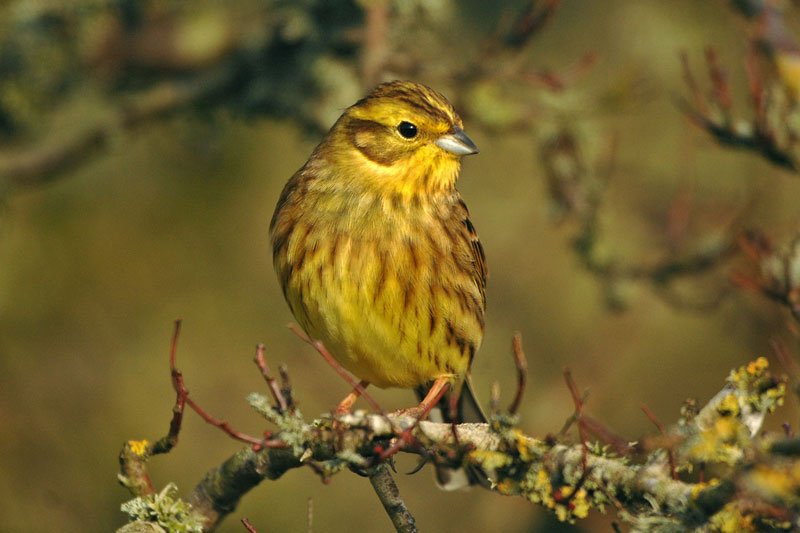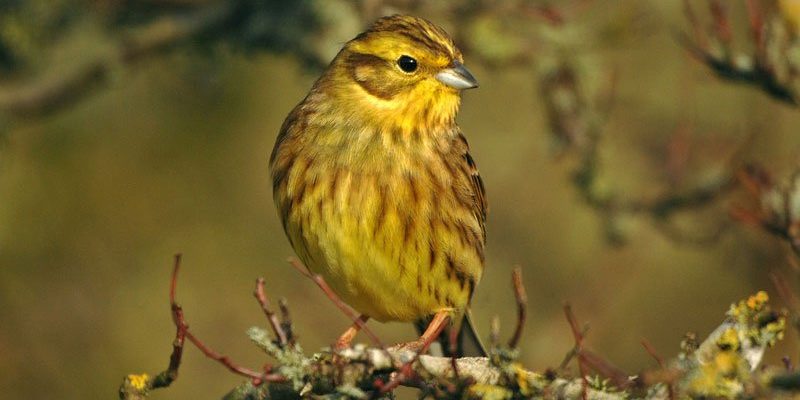
The Yellowhammer is one of those birds that captures your attention right away. Imagine a bright splash of sunshine darting across a field or perched on a fence post. This little songbird is not just a feast for the eyes; its sweet, melodic song fills the air with charm, making it a favorite among birdwatchers and nature lovers alike. You might say the Yellowhammer is like the cheerful friend who always brightens your day with a catchy tune.
Natively found in parts of Europe, Asia, and North Africa, this bird brings a pop of color to the landscape. With its striking yellow plumage and distinctive markings, the Yellowhammer is often seen in open habitats such as farmland, hedgerows, and grasslands. But there’s much more to this songbird than just a pretty face. Let’s dive deeper into what makes the Yellowhammer so fascinating.
Physical Characteristics
To truly appreciate the Yellowhammer, you’ll want to know what sets it apart from other birds. First off, these birds are medium-sized with an average length of about 15-18 cm, a wingspan of approximately 24-30 cm, and they usually weigh around 25-35 grams. Their most defining feature is their bright yellow underparts and a striking brown and black streaked back. The male Yellowhammer is particularly vivid, adorned with a sunny yellow head, while the female often has a slightly subdued color palette. This distinction helps them blend into their surroundings when nesting.
You might be wondering about their physical adaptability. Yellowhammers have strong, conical beaks ideal for cracking seeds and berries, which make up a significant portion of their diet. Additionally, their sturdy legs allow them to forage effectively on the ground, a common behavior you’ll notice when they are actively looking for food.
Interesting Facts about Yellowhammers
| Size: | 15-18 cm in length |
| Wingspan: | 24-30 cm |
| Weight: | 25-35 grams |
| Diet: | Seeds, berries, insects |
| Lifespan: | Up to 10 years in the wild |
| Habitat: | Farmlands, grasslands, hedgerows |
Habitat and Distribution
The Yellowhammer is quite adaptable when it comes to habitat. You can spot these charming birds in various environments, but they thrive best in open fields and farmland where they can find plenty of seeds and insects. They often choose to nest in hedgerows, bushes, and tall grasses, which provide shelter from predators and a cozy place to raise their young.
In terms of distribution, the Yellowhammer is primarily found across Europe, especially in the UK, where it enjoys a stable population. It’s also found in parts of Asia and North Africa. This range means that you might be lucky enough to see a Yellowhammer in your backyard if you’re in the right area. They prefer regions with a mixture of habitats, offering them both foraging grounds and nesting sites.
Migration Patterns
Unlike some birds that undertake long migrations, Yellowhammers tend to be more sedentary. They usually stay within their chosen habitats year-round, although some populations may migrate short distances to find better feeding grounds during harsh winters. However, as seasons change, you might notice them moving slightly to find areas with abundant food supplies. This behavior allows them to adapt to changing weather conditions without straying too far from their home turf.
Behavior and Social Structure
Yellowhammers are highly social birds, often found in small flocks outside the breeding season. In these flocks, various individuals will forage together, which can help them find food more efficiently. When it comes to the breeding season, however, they become more territorial. Males sing loudly to establish their presence and attract mates, and you might even catch them performing impressive aerial displays during courtship.
Their songs are a delightful aspect of their behavior. Male Yellowhammers have a distinctive, repetitive song that sounds like “a little bit of bread and no cheese.” This catchy tune serves multiple purposes: it attracts females, warns off rivals, and communicates with other members of their territory. You can often hear them singing from a prominent perch, such as a tree branch or a fence post, making it easier for you to spot them in the wild.
Feeding Habits
Yellowhammers are primarily granivorous, meaning they love to eat seeds. Their diet typically includes a variety of seeds, such as those from grasses and weeds. In the spring and summer months, however, they also incorporate insects and larvae into their diet, especially when feeding their chicks. This protein-rich food is essential for the healthy growth of their young.
When foraging, you’ll often see Yellowhammers hopping around on the ground, searching for seeds or insects. They have a unique way of scratching the ground with their feet to uncover hidden food items. If you’re keen on attracting these beautiful birds to your garden, consider planting a patch of wildflowers or leaving some areas unmanicured; they love seeds and are sure to visit!
Breeding and Nesting
The breeding season for Yellowhammers typically begins in late spring. Females are usually responsible for building the nest, which is well-hidden among grasses or hedgerows. They create a compact, cup-shaped nest using grass, moss, and other plant materials, making it an ideal fortress for their eggs. The female usually lays a clutch of 3 to 5 eggs, which are incubated for about two weeks before they hatch.
Once the chicks are hatched, both parents play a role in feeding them. This cooperation is essential for the chicks’ survival as they grow rapidly over a few weeks. After about two weeks, the young are ready to fledge, meaning they can leave the nest and start exploring their surroundings, though they often stay close to their parents for a little while longer, learning how to forage and stay safe.
Conservation Status
While the Yellowhammer was once a common sight in many rural areas, its population has seen declines in recent years due to habitat loss and agricultural changes. The shift towards intensive farming practices, which often involve herbicide use and the removal of hedgerows, has created challenges for these beautiful birds. Fortunately, many conservation efforts are underway to help protect their habitats and encourage sustainable farming practices.
Local wildlife organizations and government initiatives are working to create more favorable environments for the Yellowhammer and other similar species. By promoting the planting of hedges, wildflower strips, and maintaining diverse agricultural landscapes, they aim to provide safe nesting sites and food sources for these charming songbirds. If you’d like to support conservation efforts, consider joining local birdwatching groups or participating in habitat restoration projects.
The Yellowhammer is more than just a bright splash of color in our fields; it’s a symbol of biodiversity and a reminder of the importance of preserving our natural habitats. From its eye-catching appearance to its beautiful song, this bird brings joy to many who encounter it. As you wander through fields or gardens, keep an ear out for its cheerful tune, and remember that every bird plays a part in our ecosystem.
FAQ
What is the scientific name of the Yellowhammer?
The scientific name of the Yellowhammer is Emberiza citrinella. This name is derived from Latin, with “Emberiza” referring to the genus of bunting birds to which the Yellowhammer belongs, and “citrinella” meaning “little lemon,” a nod to its bright yellow color.
Are Yellowhammers only found in Europe?
While Yellowhammers are most commonly found in Europe, especially in the UK, they also inhabit parts of Asia and North Africa. Depending on the region and the availability of suitable habitats, these birds can adapt quite well, making occasional appearances outside their usual geographical range.
How can I attract Yellowhammers to my garden?
To attract Yellowhammers, consider planting a variety of wildflowers and leaving some areas of your garden unmanicured. They enjoy foraging for seeds and insects, so creating a diverse habitat can encourage these lovely birds to visit. Additionally, providing bird feeders filled with seeds can also help!
What do Yellowhammer chicks eat?
Yellowhammer chicks typically eat a diet rich in protein, including insects and larvae, especially during their early development stages. Their parents work hard to feed them to ensure they receive the nutrients needed for healthy growth. Once the chicks are older, they will start to eat seeds as well.
Do Yellowhammers migrate?
Yellowhammers are not known for long migrations like some other bird species. They tend to remain in their chosen habitats year-round but may move short distances in search of food during colder months. This behavior allows them to adapt without straying far from familiar territory.
How do you identify a Yellowhammer?
Identifying a Yellowhammer is relatively easy due to its striking colors. Look for the bright yellow underparts and the patterned brown and black streaked back. Males are particularly vivid, while females display more muted tones. Their distinctive song is another clue, often described as a repetitive chant that’s quite memorable.
What are the main threats to Yellowhammers?
The main threats to Yellowhammers include habitat loss due to intensive farming practices, urban development, and changes in land use. These factors have made it challenging for them to find suitable nesting sites and food sources. Conservation efforts aim to provide better habitats for these birds and their populations.
How long do Yellowhammers live?
In the wild, Yellowhammers can live up to 10 years, although many do not reach this age due to predation and environmental hazards. Their lifespan can vary depending on factors like habitat quality and available food sources, which play a significant role in their overall health and survival.
Can Yellowhammers mimic other birds?
While Yellowhammers are known for their distinctive songs, they are not particularly known for mimicking the calls of other birds. Instead, they have their unique melodic repertoire that makes them easily recognizable. Their songs serve important communication purposes, including attracting mates and defending territories.
What time of year do Yellowhammers breed?
Yellowhammers typically breed from late spring to early summer. The exact timing can vary based on local climate conditions and food availability. During this time, males will sing to establish territories and attract females, leading to nest-building and chick-rearing.
Do Yellowhammers have any natural predators?
Yes, Yellowhammers face threats from various predators, including birds of prey like sparrowhawks, as well as mammals such as cats and foxes. These predators can impact their populations, especially during the breeding season when nests are vulnerable. To mitigate these risks, natural habitats with plenty of cover are crucial for their survival.

